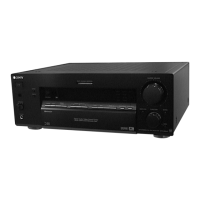
Do you have a question about the Sony STR-DB840 and is the answer not in the manual?
| Digital inputs | 2 Optical, 1 Coaxial |
|---|---|
| Power output | 100 watts per channel into 8Ω (stereo) |
| Frequency response | 10Hz to 100kHz |
| Total harmonic distortion | 0.09% |
| Input sensitivity | 2.5mV (MM), 200mV (line) |
| Speaker load impedance | 8 ohms |
| Dimensions | 430 x 157mm |
| Tuning range | FM, MW |
| Video Connections | composite |
Safety warning about rain and moisture exposure.
General safety, operation, and cleaning guidelines for the unit.
Explains symbols and conventions used throughout the manual.
Lists items included with the receiver and initial setup steps.
Instructions for connecting FM and AM antennas for optimal reception.
Guides on connecting turntables, CD players, and tape/MD decks.
Instructions for connecting TVs, VCRs, DVD players, and game consoles.
Connects digital sources like DVD/LD players and satellite tuners.
Connects multichannel audio sources via 5.1CH INPUT jacks.
Covers AC power cord connection and secondary audio output.
Details on connecting front, rear, center, and subwoofer speakers.
Steps for clearing memory and initial system configuration.
Guides on specifying speaker parameters for optimal surround sound.
Final checks and connection verification before operating the receiver.
Solutions for no sound, unbalanced audio, and hum or noise problems.
Identifies and describes controls on the receiver's front panel.
Explains MODE button, function indicators, and input mode settings.
Covers display brightness, information display, and tuner controls.
Details buttons for surround sound, speaker levels, and system setup.
Covers naming functions, equalizer, and speaker output selection.
Explains the benefits and types of surround sound modes available.
Guides on choosing and activating different sound field settings.
Detailed explanations of various cinema and music sound field effects.
Interpreting indicators for signal type, channel playback, and sound field status.
Fine-tuning audio characteristics like wall type and screen depth.
Setting individual speaker volume levels and balance.
Customizing bass, midrange, and treble frequencies for each speaker.
Explains how to tune into FM and AM radio stations.
Automatic storage of clear FM and RDS stations.
Manual frequency entry and automatic station scanning.
Saving and recalling preset radio stations.
Utilizing RDS features like displaying station names and program types.
Assigning custom names to stations and input sources.
Instructions for recording audio to tape/MD and video to tape.
Setting the receiver to turn off automatically after a specified time.
Configuring system settings like auto function and remote control.
Explains the system for controlling multiple Sony components.
Guides to diagnose and resolve operational problems.
Technical details including power output and frequency response.
Definitions of technical terms related to audio and surround sound.
Reference tables for customizable parameters via SUR, LEVEL, EQ, and SET UP buttons.
Safety warnings and introduction to the remote's manual.
Identifies and describes the buttons and features of the remote control.
Explains the basic operations of each button on the remote.
Further details on remote buttons for bass boost, on-screen display, and levels.
Guides on using menu operations and specific component controls (VCR, DVD, SAT).
Shows which remote buttons control different types of components.
How to display and navigate lists on the remote.
Hierarchical view of lists accessible via the remote.
Procedure for selecting a component to control using the remote.
How to select sound fields using the remote control.
Customizing the remote to control various audio/video components.
Creating sequences of commands for automated operations.
Adjusting backlight and clearing remote memory.
Solutions for common remote control issues.
Technical specifications of the remote commander.